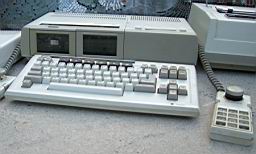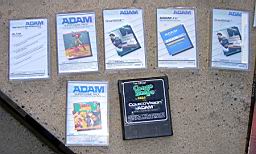The Coleco Adam was a home computer, an attempt in the early 1980s by American toy manufacturer Coleco to follow on the success of its Colecovision game console.

The system
The Adam (supposedly given its name because the manufacturer hoped it would take a "bite" out of Apple Computer's market share) was not very successful, partly because of early production problems. Announced in June 1983 at the Summer Consumer Electronics Show, executives predicted sales of 500,000 by Christmas 1983. As it turned out, only a small number of units actually shipped that year, preventing it from taking advantage of the video game crash of 1983. From the time of the computer's introduction to the time of its shipment, the price also increased, from US$525 to $725.

Mucho software
In its favor, the Adam had a large software library from the start. It was derived from and compatible with the Colecovision's software and accessories, and, in addition, the popular CP/M operating system was available as an option. Its price gave a complete system: a 64 KB RAM computer, tape drive, letter-quality printer, and software including the Buck Rogers: Planet of Zoom video game. The IBM PCjr sold for $669 but included no peripherals, and although the popular Commodore 64 sold for around $200, its price was not much lower after the purchase of a printer, tape or disk drive, and software.
Besides being available as a complete computer, there was also a less-expensive version of the Adam that plugged into a Colecovision, which promised to be an inexpensive way for Colecovision owners to upgrade to a full-blown computer system. Like many computers of its day, it was intended to use a television set for its display.
The Adam received some good reviews based on the quality of its keyboard and printer, and it offered competitive sound and graphics capabilities. In addition, its BASIC interpreter, called SmartBASIC, was largely compatible with Applesoft BASIC, which meant that a large number of type-in programs from computer books and magazines would work with the Adam with little or no modification. Advanced or commercial software for the Apple II was incompatible, however, because the internal architectures and operating systems of the two systems differed greatly.
Unlike other home computers at the time, the Adam did not have its BASIC interpreter permanently stored in ROM, instead featuring a built-in electronic typewriter and word processor, SmartWriter, as well as the Elementary Operating System (EOS) OS kernel and the 8K OS-7 Colecovision operating system. The SmartBASIC interpreter was delivered on a proprietary format Digital Data Pack tape cassette.

Printer
The SmartWriter electronic typewriter loads when the system is turned on. In this mode, it will operate just like a typewriter, typing out letters as soon as you type them. Pressing the Escape/WP key will put SmartWriter into the word processor mode, which functions a lot like a modern word processor. Of course, you can`t get back into the typewriter mode without rebooting the system.
In spite of its strengths, the Adam was not without weaknesses. Since Coleco made the unusual decision of using the printer to supply power to the entire Adam system, if the printer broke, none of the system worked. In addition, the Adam's Digital Data Pack drives, although faster and of higher capacity than the audio cassette drives used for competing computers, were less reliable and still not as fast as a floppy disk drive. Coleco eventually did ship a 160K 5¼ inch disk drive for it. Finally, the Adam would generate a surge of electromagnetic energy on startup, which would erase the contents of any removable media left in the drive accidentally. Some of the Coleco manuals also told the user to put the tape in before turning the computer on. They were apparently printed before the issue was known.
The problems with the Adam nearly drove Coleco to bankruptcy, and the Adam was discontinued in 1985, less than two years after its introduction. Like many computers of its era, it retained a cult following for years after its departure. A dedicated group of Adam enthusiasts gather every year at the annual Adamcon, which will celebrate its 18th anniversary in summer 2006.

